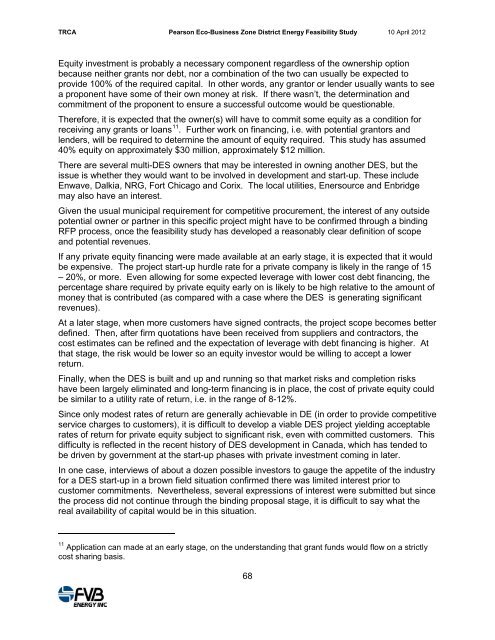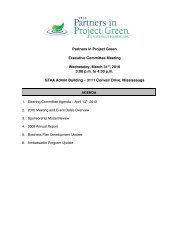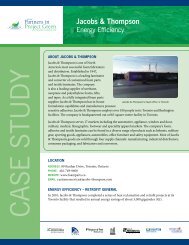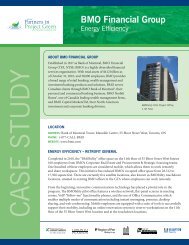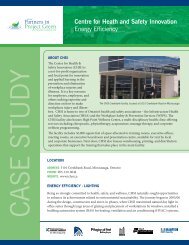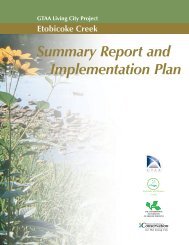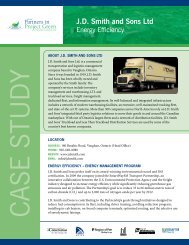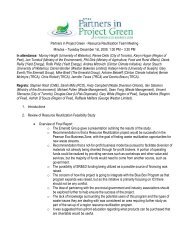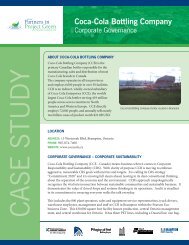Project Green District Energy Feasibility Study - Partners in Project ...
Project Green District Energy Feasibility Study - Partners in Project ...
Project Green District Energy Feasibility Study - Partners in Project ...
You also want an ePaper? Increase the reach of your titles
YUMPU automatically turns print PDFs into web optimized ePapers that Google loves.
TRCA Pearson Eco-Bus<strong>in</strong>ess Zone <strong>District</strong> <strong>Energy</strong> <strong>Feasibility</strong> <strong>Study</strong> 10 April 2012<br />
Equity <strong>in</strong>vestment is probably a necessary component regardless of the ownership option<br />
because neither grants nor debt, nor a comb<strong>in</strong>ation of the two can usually be expected to<br />
provide 100% of the required capital. In other words, any grantor or lender usually wants to see<br />
a proponent have some of their own money at risk. If there wasn’t, the determ<strong>in</strong>ation and<br />
commitment of the proponent to ensure a successful outcome would be questionable.<br />
Therefore, it is expected that the owner(s) will have to commit some equity as a condition for<br />
receiv<strong>in</strong>g any grants or loans 11<br />
. Further work on f<strong>in</strong>anc<strong>in</strong>g, i.e. with potential grantors and<br />
lenders, will be required to determ<strong>in</strong>e the amount of equity required. This study has assumed<br />
40% equity on approximately $30 million, approximately $12 million.<br />
There are several multi-DES owners that may be <strong>in</strong>terested <strong>in</strong> own<strong>in</strong>g another DES, but the<br />
issue is whether they would want to be <strong>in</strong>volved <strong>in</strong> development and start-up. These <strong>in</strong>clude<br />
Enwave, Dalkia, NRG, Fort Chicago and Corix. The local utilities, Enersource and Enbridge<br />
may also have an <strong>in</strong>terest.<br />
Given the usual municipal requirement for competitive procurement, the <strong>in</strong>terest of any outside<br />
potential owner or partner <strong>in</strong> this specific project might have to be confirmed through a b<strong>in</strong>d<strong>in</strong>g<br />
RFP process, once the feasibility study has developed a reasonably clear def<strong>in</strong>ition of scope<br />
and potential revenues.<br />
If any private equity f<strong>in</strong>anc<strong>in</strong>g were made available at an early stage, it is expected that it would<br />
be expensive. The project start-up hurdle rate for a private company is likely <strong>in</strong> the range of 15<br />
– 20%, or more. Even allow<strong>in</strong>g for some expected leverage with lower cost debt f<strong>in</strong>anc<strong>in</strong>g, the<br />
percentage share required by private equity early on is likely to be high relative to the amount of<br />
money that is contributed (as compared with a case where the DES is generat<strong>in</strong>g significant<br />
revenues).<br />
At a later stage, when more customers have signed contracts, the project scope becomes better<br />
def<strong>in</strong>ed. Then, after firm quotations have been received from suppliers and contractors, the<br />
cost estimates can be ref<strong>in</strong>ed and the expectation of leverage with debt f<strong>in</strong>anc<strong>in</strong>g is higher. At<br />
that stage, the risk would be lower so an equity <strong>in</strong>vestor would be will<strong>in</strong>g to accept a lower<br />
return.<br />
F<strong>in</strong>ally, when the DES is built and up and runn<strong>in</strong>g so that market risks and completion risks<br />
have been largely elim<strong>in</strong>ated and long-term f<strong>in</strong>anc<strong>in</strong>g is <strong>in</strong> place, the cost of private equity could<br />
be similar to a utility rate of return, i.e. <strong>in</strong> the range of 8-12%.<br />
S<strong>in</strong>ce only modest rates of return are generally achievable <strong>in</strong> DE (<strong>in</strong> order to provide competitive<br />
service charges to customers), it is difficult to develop a viable DES project yield<strong>in</strong>g acceptable<br />
rates of return for private equity subject to significant risk, even with committed customers. This<br />
difficulty is reflected <strong>in</strong> the recent history of DES development <strong>in</strong> Canada, which has tended to<br />
be driven by government at the start-up phases with private <strong>in</strong>vestment com<strong>in</strong>g <strong>in</strong> later.<br />
In one case, <strong>in</strong>terviews of about a dozen possible <strong>in</strong>vestors to gauge the appetite of the <strong>in</strong>dustry<br />
for a DES start-up <strong>in</strong> a brown field situation confirmed there was limited <strong>in</strong>terest prior to<br />
customer commitments. Nevertheless, several expressions of <strong>in</strong>terest were submitted but s<strong>in</strong>ce<br />
the process did not cont<strong>in</strong>ue through the b<strong>in</strong>d<strong>in</strong>g proposal stage, it is difficult to say what the<br />
real availability of capital would be <strong>in</strong> this situation.<br />
11<br />
Application can made at an early stage, on the understand<strong>in</strong>g that grant funds would flow on a strictly<br />
cost shar<strong>in</strong>g basis.<br />
68


